-
Posts
133 -
Joined
-
Last visited
Content Type
Profiles
Forums
Blogs
Gallery
Events
Store
Posts posted by milhistry
-
-
I am missing a few pages of the 1934 Dress Regulations for the Union Defence Forces. If anyone is able to provide a scan of the following pages it would be greatly appreciated. The copyright on these has long expired!
Pages I require:
* Contents page
* Page 9 (especially the bottom half of the page about buttons)
* P 21-22
* Para 61
I seem to be missing Pages 21-32 - if anyone can shed light on what those cover it would be appreciated.
0 -
I am after a scan or copy of Page 85 of Commando magazine for October 1968. If anyone is able to assit that would be great. Thanks.
0 -
I am after a scan or copy of Page 60 of Commando magazine's February 1968 issue dealing with badges of the ASC, TSC, Q'SC and predecessors. If anyone is able to help with either a scan or a summary of the information it would be greatly appreciated. Thank you.
0 -
These are not ranks per se but appointments/titles. Their rank could be Colonel or Major-General for example while their appointment might be DAAG and AG. The addition of "-general" to the appointment name does not neccessarily mean that they have to be a general officer either.
0 -
The practice of purple distinguishing cloth was also adopted from the merchant marine by flight engineers in the civil aviation field.
Incidentally, the Womens Royal Naval Service also used lozenges, although theirs were on top of the rank lace and were light blue in colour.
0 -
I was mainly thinking WWII. I have heard of Hill. Who were the others?
Africa Service Medal naming might be a good topic to start as a new discussion as I'm sure there will be some unusual namings out there. My relative in question was a Lieutenant (I have copies of his service records confirming this) yet his medals are named only with his sevice number, V, initials and surname. Perhaps it depends on when/by whom the medals were issued? Another relative was a major in the Permanent Force. His War & Africa Service medals are simmilarly named but his number is prefixxed with a P for Permanent Force.
0 -
General Post Office perhaps?
0 -
I have only seen one of these before in metal.The story that went with it was also that it was a briefly worn WOII badge worn in the 'fifties.
Have also seen a picture of the red on black embroidered version.
The SAN was, I think, somewhat forced to introduce WOI & WOII in the 1950s once the SA Corps of Marines was disestablished and most of its pers were absorbed into the SA Navy instead.
The crown was officially replaced in 1957 for WOII in the other services but only in 1958 did people actually start wearing the new badges. Some more recent SAN WOII badges attached. The blue on white was worn on the blue shirt (Action Work Dress) in the 1990s. I'm not sure about the one on the right. I think it may have been worn on the black windbreaker jacket introduced in the early 1990s?
 0
0 -
Nice group! The only other MC to a SA Chaplain that I can recall is "Doompie" Cloete (WR/DLR padre in WWII, later 2 Sqn SAAF in Korea and eventually Chaplain-General of the SA Police).
Interesting naming on the Africa Service Medal. I do wonder whether in this case ACF does not stand for Acting (or Asst) Chaplain to the Forces rather than Active Citizen Force. Medals to relatives who were in the Active Citizen Force only have their number followed by a "V" (for Volunteer). It is intersting to see his has no regimental number. I assume the 39-45 War Medal is missing?
0 -
Warrant Officers wore the standard size metal badges on Mess Dress, Black. Embroidered badges were also worn pre-WW2 and more recently but when metal ones were worn in the 1980s & 90s they were normal size.
I have one of these smaller as well and had various theories about it.
(A) A larger type of coat-of-arms was worn c. 1914-15 as a general service cap badge. This supports the idea of a general service collar badge, but collar badges were not that commonly worn in the SA Forces in WW1. The SA Mounted Riflemen (Permanent Force) did not wear them on SD nor did the Commandoes. Most of the WW1 early GS cap badges (i.e. large coat of arms type) were cast, not struck, while the badge you show and everyone like it that i've seen appears to have been struck rather than cast.
(B) The SA Railways as well as the SAR&H Police (SARP) also used the coat of arms as a cap badge, with additional lettering on a scroll below etc.
I cannot remember Railways wearing collar badges. This does not of course mean they never did!
© Railways Police.
Photographs of SARP of this period indicate that the other ranks wore RP/SP titles on their lapels with the coat of arms on the helmet (late 1940s photograph). I am not sure whether SARP officers may have worn collar badges, (their SA Police counterparts did at the time). If that was the case, then the small coat of arms could possibly be a SARP officers collar badge pre 1955? If you have Owen's book - the SARP badge pre-1955 is #1886. The WW1 early GS badge is #1885. I see there is indeed a SARP collar badge in Owen's book but it has a scroll underneath the coat of arms (#1878 & 1879).
(D) Another theory I have had is that it may be some form of "sweatheart" badge.
Having had a better look through Owen's book...the small badge was apparently the collar badge of the "SA Railways & Harbours Rifles"! Would be good to get another source to back that up though. Perhaps someone knows a bit more baout this unit?
0 -
South African Marine Brigade (1980-90) WO1 for field dress. Not sure if WMAA wore this as well or whether they wore the standard "red" WMAA badge? Any "Brown Navy" folks out there who may know?
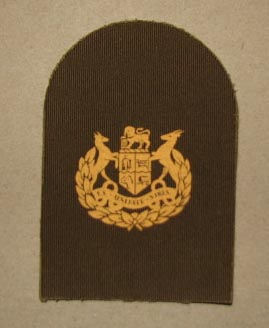 0
0 -
RNZAF W/O and W/O (Air Training Corps). The Air Force have more recently taken to wearing badges that look more like bullion.
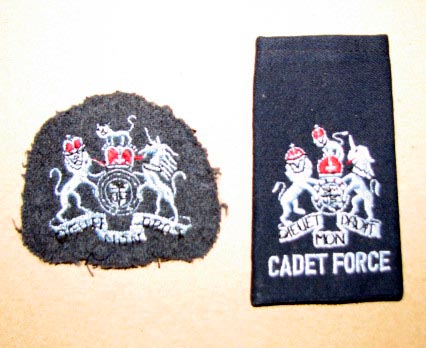 0
0 -
-
New Zealand Army WOII & WOI. In NZ all WOII wear the wreathed crown. The NZ coat of arms replaced the Royal Arms for Army WOI in the 1970s. The Air Force and Navy have only one class of Warrant Officer, each wearing the Royal Arms, presumably because the Air Force and Navy have the "Royal" prefix.
0 -
In my previous post I forgot to mention the obvious - the BSM/GSM had a green backing. RSMs in the Army / MWAA in the Navy had a red backing.
Also worth noting is that prior to 1958, South African WOIs wore the Coat-of-Arms with or without wreath depending on appointment. WOIIs wore the crown with or without wreath depending on appointment (Company/Battery/Squadron SMs wore the crown only, pretty much everybody else wore the wreath around the crown). In 1958 the crown was dropped altogether and the wrethed arms (formerly worn by Garrison Sgt Maj, Conductors etc) became the badge for all WOIs. The arms without wreath, previously worn by RSMs and most other WOIs, became the badge for all WOIIs in 1958.
0 -
SA Brigade Sergeant-Major or Group Sgt Maj (for the Commando Groups) c. 1980s to 2000s.
While Citizen Force Regiments/Battallions/Batteries were "Brigaded" together, the Commando Forces (ie. territorial reserve) units were formed into "Groups" consisting of a few "Commandoes" each.
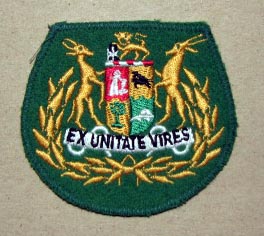 0
0 -
-
Brian - some very interesting research and a long time since I've seen the history of Police Helmets thoroughly explored. There should be many more threads to be added - including Women Police and New Zealand and Gibralter.
...
I hope that members with helmet collections will start posting some examples - even if they have been on before your Post will give reference.
Two New Zealand Helmets are shown here with a modern Met helmet in the background for comparrison. Prior to 1976 they were either dark navy/black or white. In 1976 the NZ Police changed to a victrix blue uniform. The helmet on the left is thus post 1976. By the 1990s they were all wearing forage caps / SD caps. The blue one was made in NZ and this particular white example was made in Australia. The kiwi helmets were much lighter and thinner than their British counterparts and prone to cracking. Unfortunately the white one is missing ventilator and band but it gives an idea of what they looked like. White helmets were common in NZ and I can't recall if they were summer dress (with dark helmet worn in winter) or daytime dress (dark helmet worn at night).
0 -
Lead grey Summer Dress c. 1970s/early 1980s. Collar dogs would have been worn on the collar, I think.
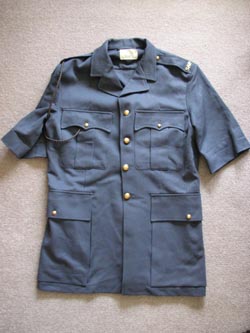 0
0 -
Close up of the shoulder board and collar dog
 0
0 -
Service Dress Jacket & Trousers to a Lieutenant as worn 1980s. The hard shoulder boards for officers were introduced in the 1970s. Constables,NCOS and Warrant Officers wore "SAP" letters on the shoulder strap.
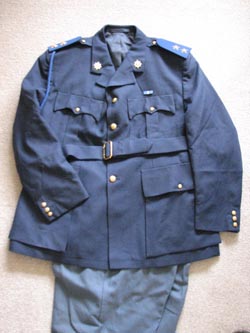 0
0 -
Service Dress Jacket & Trousers to a Lieutenant as worn 1980s. The hard shoulder boards for officers were introduced in the 1970s. Constables,NCOS and Warrant Officers wore "SAP" letters on the shoulder strap.
0 -
-
Here is a pic of the uniform
 0
0







1934 Dress Regulations
in Great Britain: Empire: Colonial Including South Africa & India: Awards, Militaria & History
Posted
I know the War Museum in Jhb had a copy in the library five years ago...